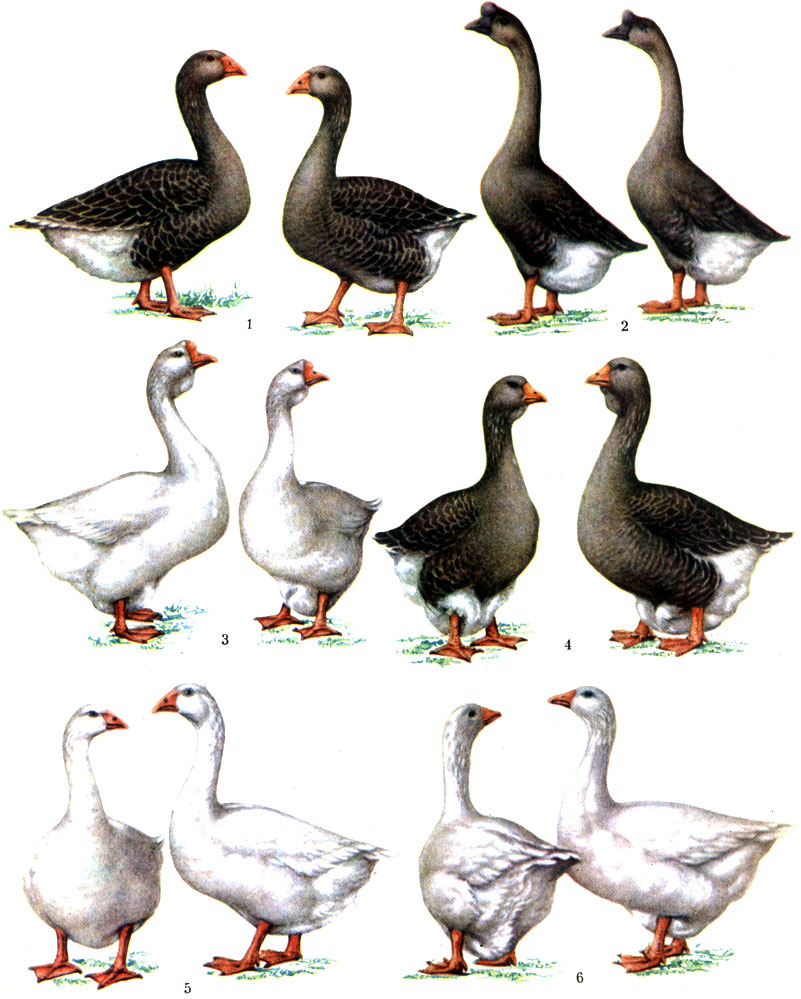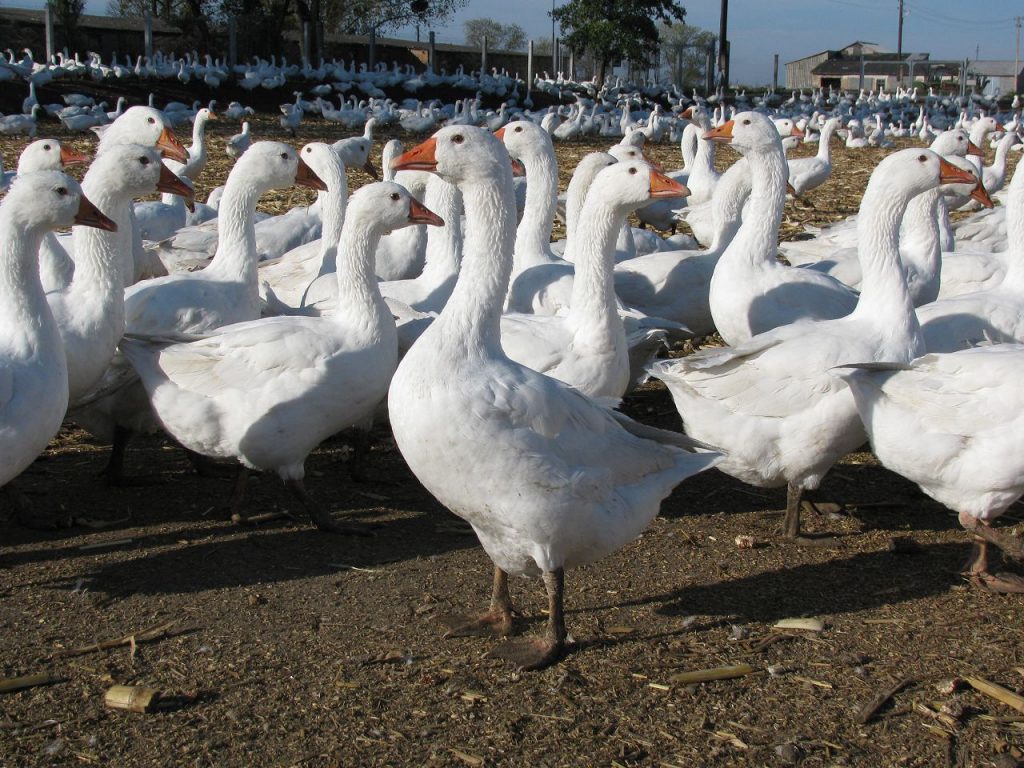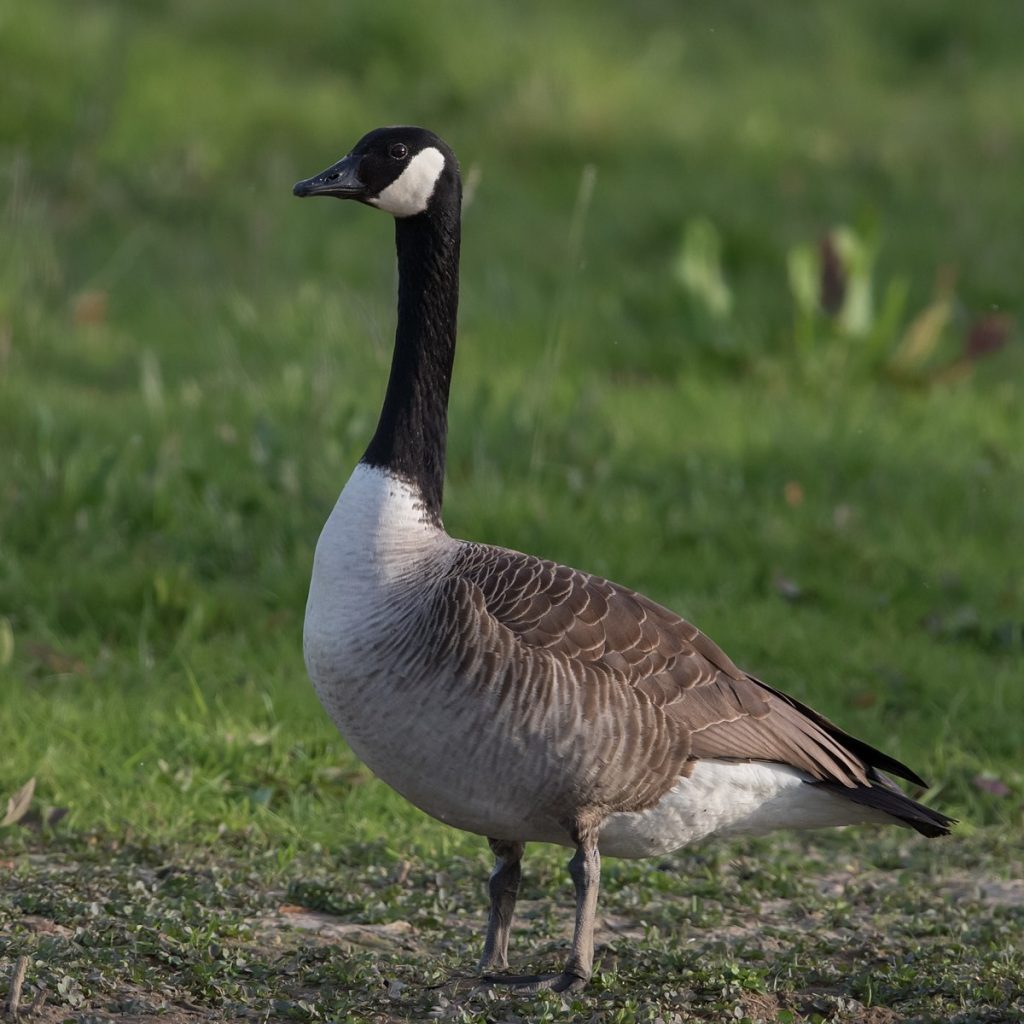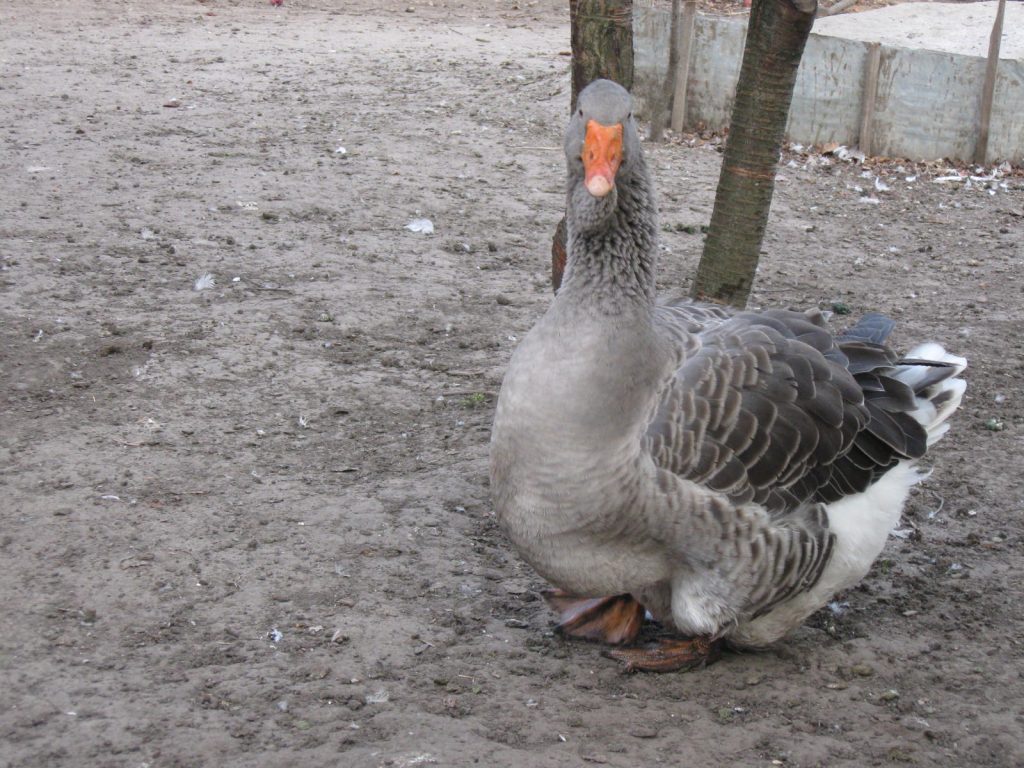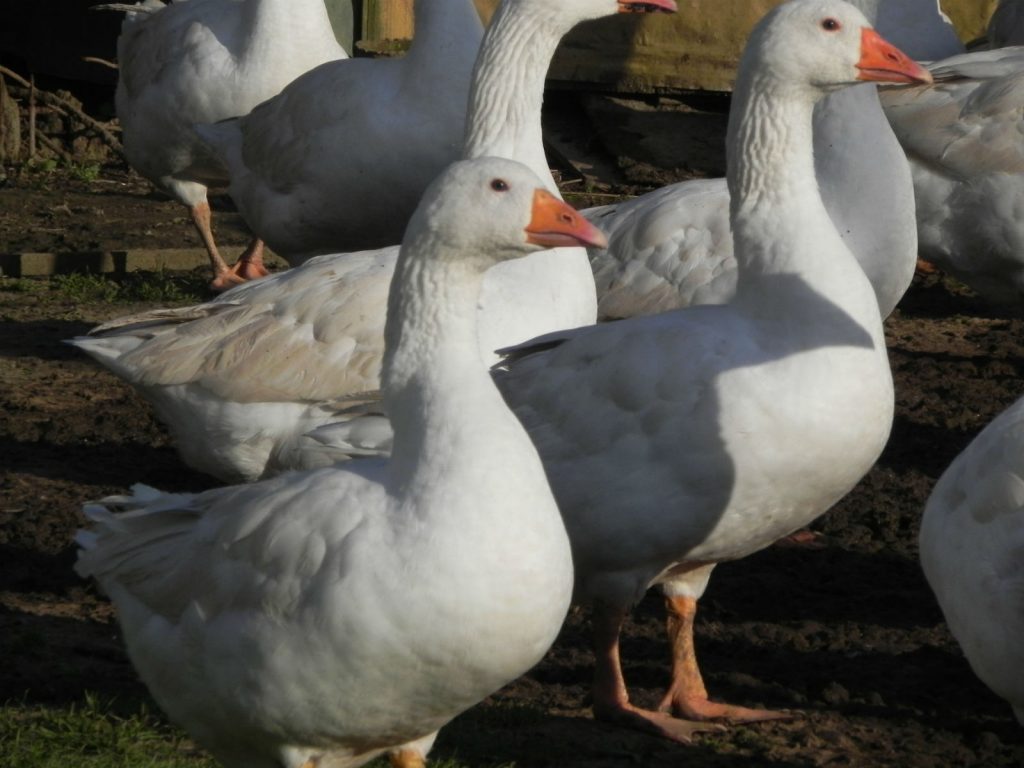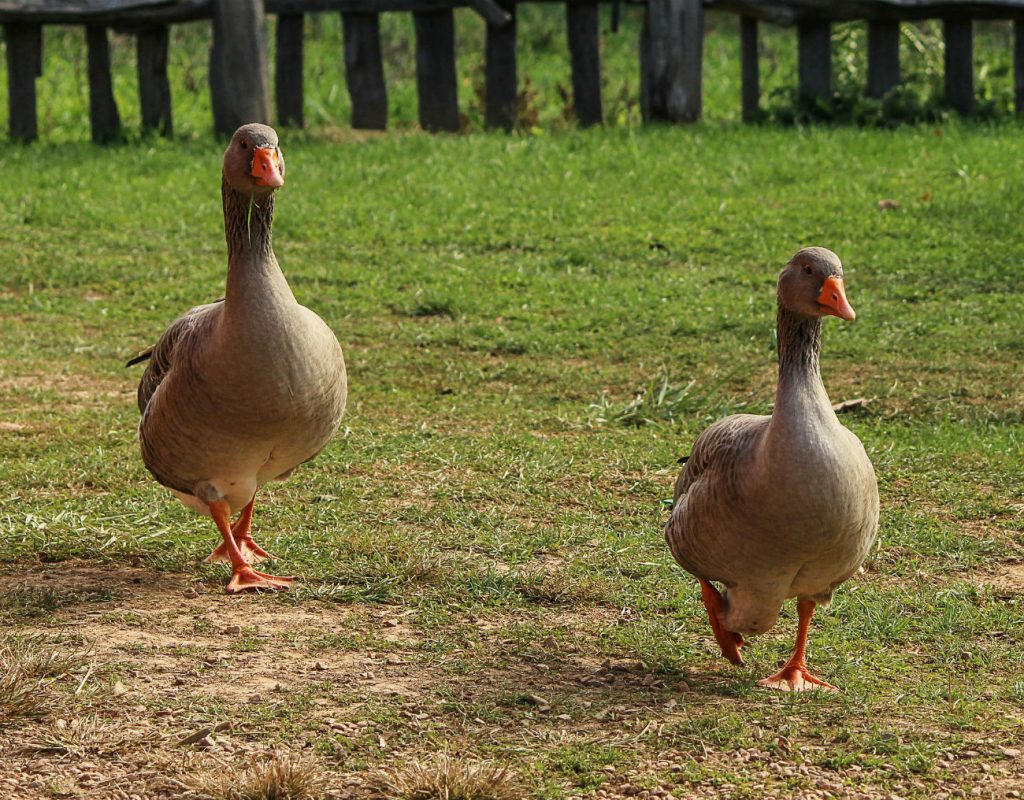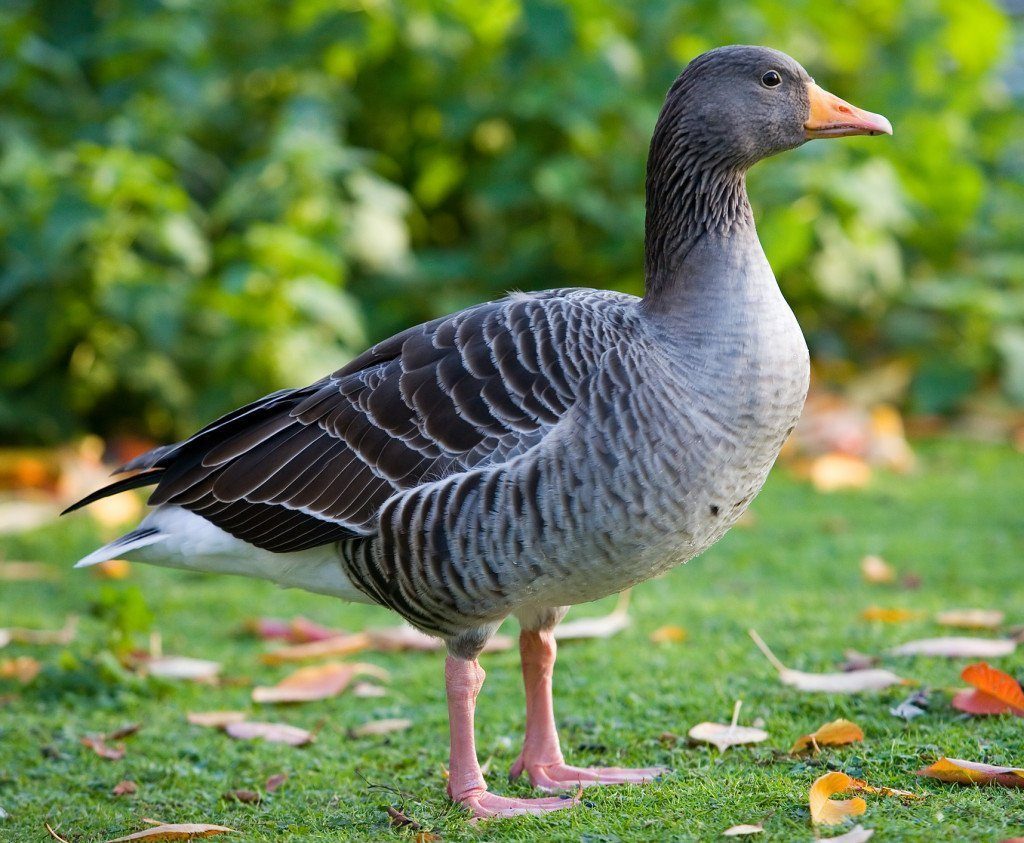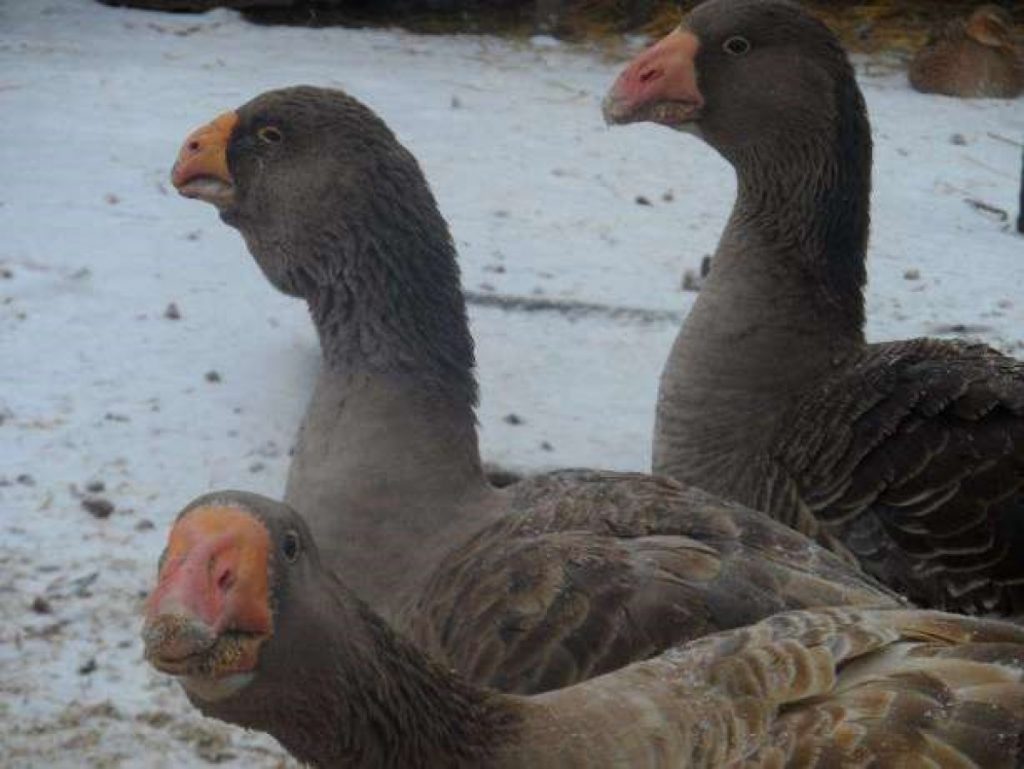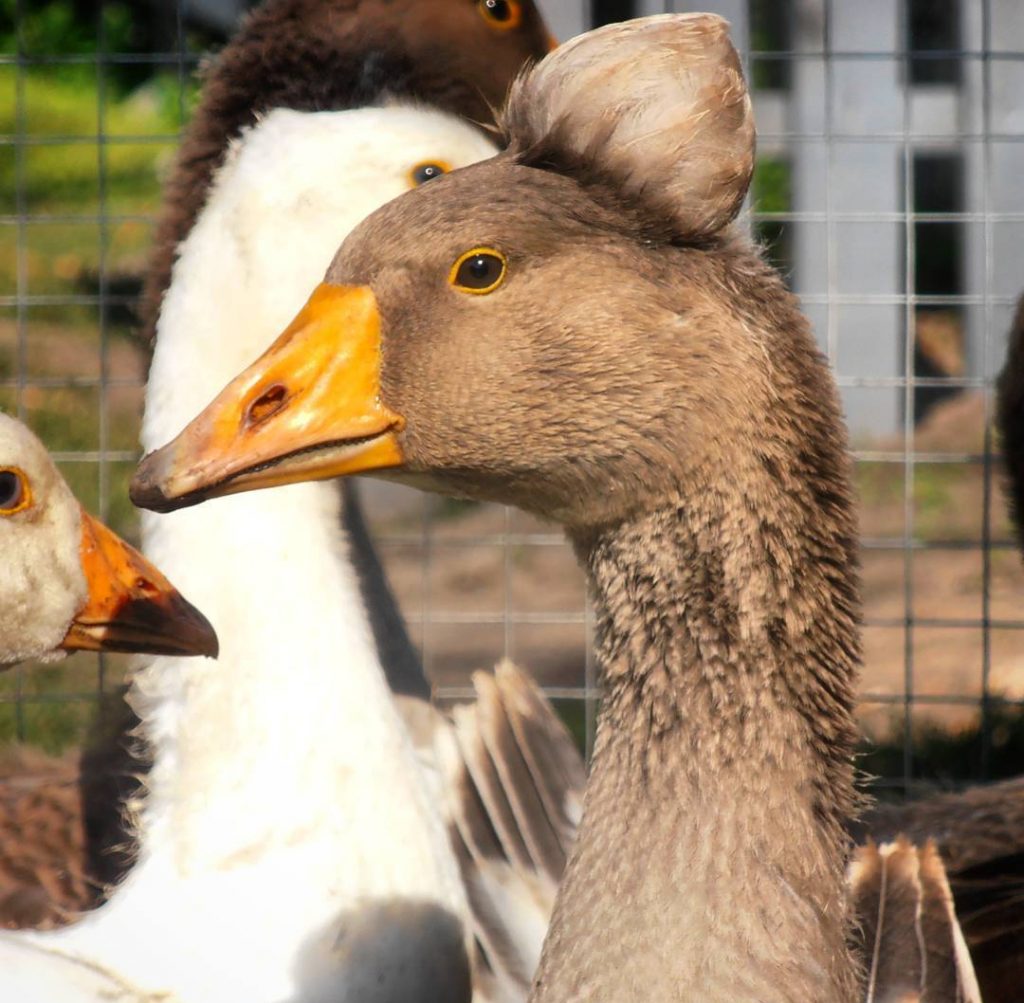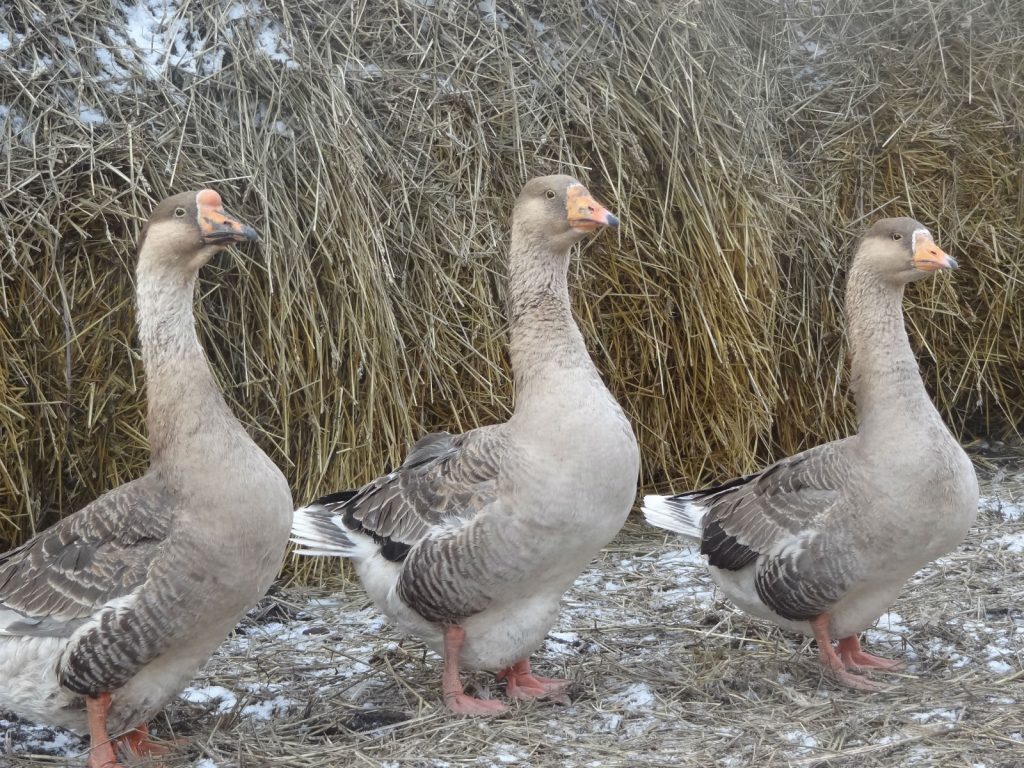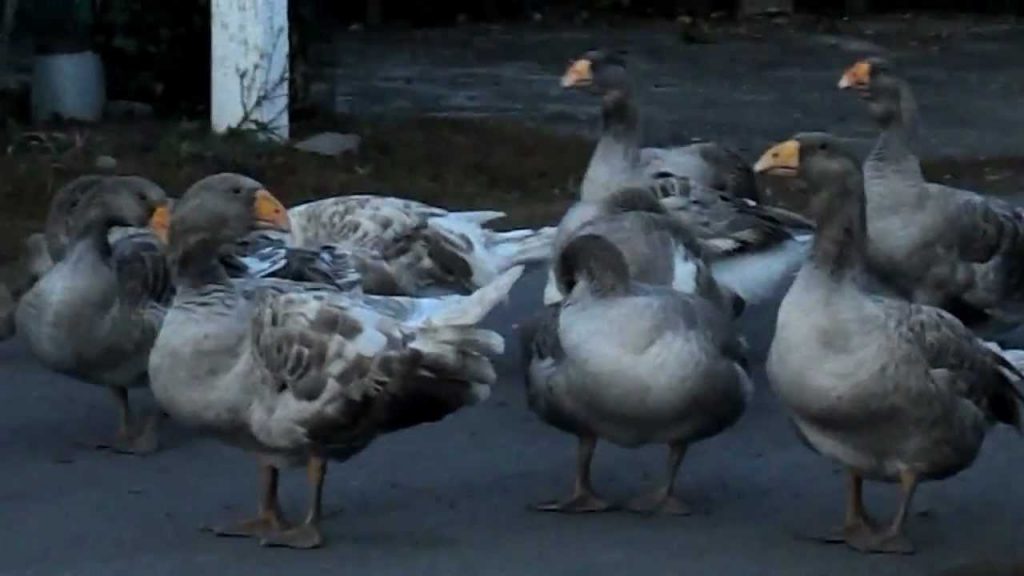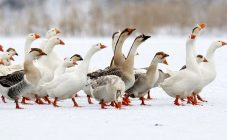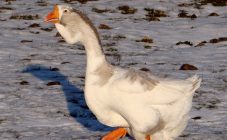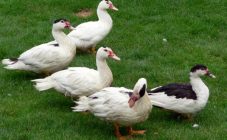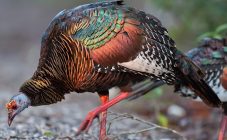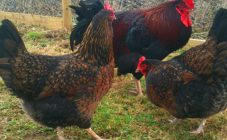Content:
The goose is one of the most ancient domestic birds, which originates from the dry-nosed and the wild gray goose. In the process of domestication, he lost the ability for long flights, but remained an unassuming waterfowl, from which new breeds of geese began to form.
The main characteristics of geese
The domestication of geese took place with one goal - to obtain meat. According to these indicators, they occupy an honorable second place after chickens. Chicken is the first in egg production, and geese - in meat. With intensive growth, geese are not demanding on keeping conditions and nutrition. During the summer period, they quietly graze, while saving purchased feed.
Currently, by selection, about 90 breeds of this bird have been bred, which differ in size, rate of weight gain, egg production and other indicators. Many species never became domesticated; they can be observed in the wild or in zoos. These species include Mountain Geese and Black Geese.
No less interesting is the breed of wild White-fronted geese - the most unusual representative of the breed. The male voices the call for mating in the spring and protects the female for the entire nesting period. He may be near water, but he lives exclusively on land. They prefer to nest in places with tundra.
A little more than 20 breeds are used for growing at home, before you start breeding this bird, it is necessary to determine what qualities it should be. Each newly developed breed has inherent distinctive qualities that characterize them.
But basically they are divided into the following subspecies:
- lungs;
- medium-heavy;
- heavy.
Geese are distinguished by good digestion of green grass and fiber. They have record high growth rates. From the moment of birth to 2 months of age, nestlings of geese increase their body weight by 30-40 times, at the expense of 3 kg of concentrated feed per 1 kg of weight. The weight of an adult goose, depending on the breed, ranges from 7-9 kg.
When selling goose meat and other products, there is almost no waste. More than 70% of meat, fluff, feathers, eggs are on sale.
Goose liver is of particular value - some breeds are specially fattened to increase the mass of this delicacy. These breeds include Toulouse geese and Landski geese.
Geese have a long life span, and 2-3 years after birth, their reproductive period increases, the goose begins to lay eggs by 30% more than before.
Linda
An interesting breed that was bred by crossing Chinese and local breeds. As a result, we got a new meat type of geese with good egg production. More than 50 eggs can be laid by a goose for procreation.
The domestic Lindovsky goose looks beautiful in the courtyard, thanks to its appearance:
- plumage - snow-white;
- beak - curved, red, above it - a large bulge on the forehead;
- under the beak - a skin fold identical to the fold on the abdomen;
- the weight of an adult bird is 7-8 kg.
Landa geese can be sent for walking within 40-45 days after birth.The female begins to reproduce early - after 7.5-8 months she is ready to sit on the nest. During seasonal molting, this breed does not stop growing.
Danish Legart
A large, flexible bird with the highest quality down, it was bred in the Danish kingdom.
She has a truly royal look:
- an elongated torso - with a beautiful posture;
- beak - beautifully shaped, yellow;
- legs - yellow, gait - graceful;
- plumage - snow-white, without the slightest color, goose down is gentle and airy.
The Danish Legard goose has a very peaceful and friendly character, it is not picky about food, it is unpretentious. But their egg production is low - about 35 eggs.
The whole world appreciates Legart for the high quality of snow-white fluff, which he shares every month and a half. With the minimum food consumption of the Legard goose, the body weight of an adult is up to 8 kg. Its maintenance costs minimal investments, besides, the white goose will decorate any courtyard.
Canadian
Originally from America, has long been a favorite target for hunters. Canada goose was even listed in the Red Book. The waterfowl has another name - Goose, and it has more than 10 subspecies. They like to live near a forest and a reservoir.
An adult weighs more than 6 kg, body length - about 1 m.Differs in a wide wingspan - up to 2 m.
If not for its impressive size, from a distance it could be mistaken for a duck:
- the head is round, elongated, with black, shiny plumage, on the forehead there is a small white spot, for this it was nicknamed the White-fronted goose;
- the neck is long, curved, the plumage casts blue, turns white on the chest and looks like a necklace;
- beak and legs are black;
- tail - with long blue feathers.
The food of the Canadian goose is varied; they gladly eat grass and small insects, mollusks, and fish. Swimming in open reservoirs, they communicate with relatives, making a loud sound.
For breeding, they always fly to warm countries, because mating begins in early spring.
Toulouse
Large, heavy, overweight birds - this is how domestic Toulouse geese look. They got their name in honor of the city of the same name in France, where they were first bred, adults weigh 10-12 kg.
Bird description:
- large rounded head covered with short dark gray feathers;
- the neck is long, at the base there is a large bulge;
- belly with fatty deposits, covered with white feathers;
- the wings are wide, with large feathers, gray.
The female has a good egg production - for laying she carries more than 40 eggs, begins to incubate at the age of ten months.
The nature of the bird is peaceful, undemanding, they are inactive, so a corral is not needed for keeping them.
Birds quickly gain body weight, but at the same time lose their ability to reproduce. When sold, the liver of this breed is valued, which weighs more than half a kilo.
Poorly tolerates a damp climate, breeding is recommended in warm climates.
Hungarian
The name speaks of the goose breeding place. At the end of the 70s, Hungarian breeders registered it, and this species was bred by crossing local individuals with the Pomeranian breed. Russia became the second home for this breed at the end of the last century.
The Hungarian goose has the following characteristics:
- neck - thick, medium length;
- plumage - white, with gray spots;
- the beak is large, the legs are powerful, orange;
- the wing is large and strong.
The breed belongs to heavyweights, body weight reaches 9 kg. Young animals gain weight quickly. Females lay about 40 eggs, weighing 130-140 g.
A very characteristic bird, quarrelsome, often provokes conflicts, so it must be kept in an aviary, separate from other domestic birds and animals. This is the main condition for its content.
Hungarian is a versatile bird, it can be grown for the production of fluff, meat and liver.
The bird is demanding in terms of keeping conditions, for good productivity it needs good nutrition, walking conditions and a warm house.
Shadrinsk
A handsome gray man with a proud bearing is incredibly popular. For a long time, selection work was carried out, the best individuals were selected for breeding the breed.
As a result, a bird came out with a not very large body weight, but worthy of attention:
- plumage - from gray to white;
- a small head with an orange beak;
- belly - with skin folds;
- paws - pinkish;
- convex breast, small wings, pressed to the body.
Shadrinsky goose is very muscular and fit. It is unpretentious, not picky about food and adapts well to any climatic conditions.
Very resilient, active and hardy. He has marbled meat with excellent taste.
The disadvantages of this breed are considered small weight gain and weak egg production - no more than 30 eggs. But the bird has good immunity and always healthy offspring.
Broiler
This is a type of large, heavyweight geese that quickly gain weight. Basically, these are meat breeds, some are also suitable for the production of high-quality fluff.
Broiler geese have the following distinctive features:
- muscular, powerful physique;
- large belly with fat deposits;
- wide wingspan;
- a voluminous, enlarged chest;
- short, powerful neck.
The plumage of such geese is different, depending on the characteristics of the breed. Keeping requires a well-equipped poultry house, a sufficient amount of feed, and free access of birds to the reservoir. Broiler goose does not tolerate cold well, therefore it is necessary to provide heating for it in winter. It is better to use an incubator for breeding such breeds.
Demidov
There is no separate breed under this name. This is the name of related breeds. This is a collective image of the Lindovsky, Ural and Italian breeds.
Italian is a productive meat and egg breed, an excellent supplier of goose liver, which grows up to half a kilogram. The Demidov gander weighs 7-8 kg, the young quickly gain weight - after 50 days the goslings gain about 4 kg.
Lindovskaya is a productive, egg-bearing breed. They reach a weight of 8 kg, the goose carries more than 50 eggs. She has good fertility, easily adapts to climatic conditions, unpretentious.
African
The look of a proud aristocrat distinguishes this majestic breed from others. It is not for nothing that breeders use the African to improve some breeds of geese. Some breeds already have the proud African headset. The origin of the heavy goose is not known; it was first standardized at the end of the 20th century in England.
Meat breed, an adult African gander, weighs up to 10 kg, females - a little less. Color options for individuals: ash, white, brown. The color of the beak and legs depends on the color of the bird. The whites are orange, the grays are black. There is a growth above the beak.
The goose lays no more than 30 large eggs, the young develop slowly. Goslings mature at about 1.5 years.
The bird's character is calm, livable. It is considered a long-liver, there is resistance to cool climates, but in severe frosts it can freeze the growth over the beak. In winter, it is necessary to keep in an insulated poultry house.
Dutch
Holland breeders specialize in breeding new breeds of waterfowl. Good natural conditions, rich abundance of green fodder stimulate local farmers to breed new breeds of geese. Therefore, this name means those types of waterfowl, the ancestor of which was Holland.
Breeding Dutch geese are the elite among heavy meat breeds. They are resilient, hardy, and have good breeding ability. Young animals gain weight quickly.
Landau
The main direction of cultivation of this breed is Landau's fattening to obtain a tender goose liver. For this, a special feeding scheme has been developed, birds are limited in movement, slaughter is carried out at a certain time of their life. This breed grows the largest liver - up to 0.7 kg.
In addition to this direction, Landau is successfully grown for meat, feathers and eggs. If fattening is carried out to obtain a liver, then reproductive capacity is significantly reduced due to overeating.
Features of the breed:
- the bird is frost-resistant, unpretentious;
- young animals have good survival rate and are gaining weight quickly;
- at the age of two months, goslings weigh up to 5 kg;
- plumage - speckled gray, orange beak and brown legs;
- the weight of an adult bird, with good nutrition, reaches 10 kg;
- the character is quarrelsome, aggressive.
Geese have a good maternal instinct, the bird is strong, unpretentious.
Royal
To truly royal include breeds, characteristics superior to all others. All indicators are taken into account: from external beauty to productivity. Such a representative is Linda Goose. He has a purely snow-white plumage, yellow legs and beak. There is a tubercle above the beak.
The poultry is of intensive maturation, the young quickly gain weight. Young goslings are resilient with good survival rates. The weight of an adult bird is 9 kg for a male, 7 kg for a female. They are distinguished by high egg production and excellent meat taste.
Kucherbayevskaya
In Ukraine, in the middle of the 20th century, on the basis of the Obroshin breed, a new species of geese was bred - Kucherbayevsky. The breed does not differ in large body weight - about 7 kg, but it has good survival rate and vitality. Young animals quickly gain weight, meat has good organoliptic indicators. In addition, up to 0.7 kg of a beautiful, steel-colored feather is obtained from one individual.
Outwardly, the bird looks like this:
- plumage - gray, closer to the head - a black stripe;
- beak and legs - brown, with yellowness;
- belly - without fat folds;
- above the beak - no build-up;
- the body is small, muscular;
- wings - tightly pressed to the body;
- neck - straight, medium length.
The female carries up to 40 eggs, from which 80% of the viable goslings hatch.
Fighting
Spectators could not ignore such a muscular bird like a goose.
The selection of such geese was aimed at strengthening the muscles, certain parts of the body should be as follows:
- beak - short, massive, hard;
- body weight - as much as possible;
- the upper part of the wing is muscular and strong.
The nature of the bird also mattered - it must be aggressive, tireless in the fight.
Studying the catalog of breeds of fighting geese, it is clear that there are only heavyweights.
One of the representatives of this breed is the Tula goose. It was grown under certain conditions only for fighting. These are hardy, strong geese that adapt well to different conditions.
Also, the series of Kuban geese are referred to breeds that have a fighting character. The breed is not very large, but they are distinguished by their endurance.
Chicken goose
Going to the site, when studying the breeds of geese, you can find an outlandish bird with beautiful gray-blue feathers. A very nimble bird, similar to a goose, but almost never enters the water. This is the Chicken Goose. Lives in the wild, breeds in winter, so he chooses hot countries for life. The chicken goose makes grunting sounds with its larynx, adheres to the general flock. This breed has a peculiarity: if the Chicken Goose has chosen a partner, he remains faithful to her until the end of his life.
Recommendations for growing geese
Breeding geese is a profitable and not troublesome business. Having decided to do this, you need to determine for what purposes they are needed, and choose the breed that will bring as little trouble as possible at the initial stage.
For the production of meat, it is necessary to start a heavy-weight breed; to obtain young animals, medium-weight breeds are suitable. Recently, decoration of the courtyard with decorative small breeds of geese has become popular. For this purpose, you can get Indogus or other small breeds.
In addition, you should take care of the poultry house, a paddock for walking the flock, the presence of an open reservoir, determine the amount of feed required for the good development of the bird. Of course, the nature of the bird must be taken into account, because not every breed is peaceful. If all the requirements are met, a good result will not be long in coming.
